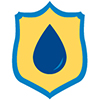6 Water Supply Threats Industry Should Assess
Businesses today face numerous threats to maintaining reliable, sustainable and affordable water supplies to support operations. Water scarcity, surface and groundwater depletion, tightening regulations, societal pressures and rising treatment and disposal costs are pushing businesses to consider evaluating their supply and incorporating additional water sources to augment it and guard against possible disruptions.
One approach to mitigate your water supply risks is to perform a source water vulnerability assessment, or a detailed look at your business’ water source(s) and its related risks. Ask yourself targeted questions about the water sources according to major risk categories and how they could affect your bottom line. Six major risk categories to consider include:
 1. Supply reliability—A reliable water supply can be measured by the potential for water shortages to occur due to a variety of internal and/or external factors. Episodic events, such as frequent floods or droughts near the plant, for example, could interrupt access to the water source. Legislative policies can affect water access depending on whether local policies protect or limit water rights. If your business is purchasing water from a local utility, the current state of the public piping infrastructure might be old and susceptible to burst, or the level of treatment provided may not be sufficient to support all of its uses. To determine supply reliability, ask: What factors within the plant or outside of it could negatively affect operations and cause interruptions?
1. Supply reliability—A reliable water supply can be measured by the potential for water shortages to occur due to a variety of internal and/or external factors. Episodic events, such as frequent floods or droughts near the plant, for example, could interrupt access to the water source. Legislative policies can affect water access depending on whether local policies protect or limit water rights. If your business is purchasing water from a local utility, the current state of the public piping infrastructure might be old and susceptible to burst, or the level of treatment provided may not be sufficient to support all of its uses. To determine supply reliability, ask: What factors within the plant or outside of it could negatively affect operations and cause interruptions?
 2. Watershed sustainability—Protecting watersheds is a universal concern. The stormwater that drains into our streams, rivers, lakes and wetlands not only supplies municipal drinking water, but it is also a major source for manufacturing and agriculture. You should ask what may be threatening the local watershed (Are land uses, or the lack of land use management threatening source water quality? Is urbanization degrading both the quality and quantity?) and identify actions to help protect it. A healthy watershed may mean the difference between a secure source and regulatory intervention.
2. Watershed sustainability—Protecting watersheds is a universal concern. The stormwater that drains into our streams, rivers, lakes and wetlands not only supplies municipal drinking water, but it is also a major source for manufacturing and agriculture. You should ask what may be threatening the local watershed (Are land uses, or the lack of land use management threatening source water quality? Is urbanization degrading both the quality and quantity?) and identify actions to help protect it. A healthy watershed may mean the difference between a secure source and regulatory intervention.
 3. Water efficiency—Water is a limited resource and for businesses operating in water-stricken regions, this risk is particularly palpable as conservation efforts grow. To improve facility water use and identify inefficiencies, manufacturing plants can perform a water audit or implement a water balance. Taking these steps may reveal low-cost solutions to water loss. Are cleaning hoses ever left running? Spring-released nozzles could be added to cut down on human error. Does fleet wheel washing require drinking-water quality water? Reusing lower-quality water could do the job, while decreasing treatment or purchasing costs.
3. Water efficiency—Water is a limited resource and for businesses operating in water-stricken regions, this risk is particularly palpable as conservation efforts grow. To improve facility water use and identify inefficiencies, manufacturing plants can perform a water audit or implement a water balance. Taking these steps may reveal low-cost solutions to water loss. Are cleaning hoses ever left running? Spring-released nozzles could be added to cut down on human error. Does fleet wheel washing require drinking-water quality water? Reusing lower-quality water could do the job, while decreasing treatment or purchasing costs.
 4. Compliance—Compliance is probably the most obvious risk to industrial water supply. While complying with regulations often adds costs, the costs of not complying are much higher. Water could be fully restricted or an operation could be shut down entirely. Here, you should assess if you are in compliance with existing mandates and how you can proactively position your business to comply with expected regulations. Getting involved in local policy roundtables is a great way to stay apprised of potential legislation and to have the voice of an organization heard.
4. Compliance—Compliance is probably the most obvious risk to industrial water supply. While complying with regulations often adds costs, the costs of not complying are much higher. Water could be fully restricted or an operation could be shut down entirely. Here, you should assess if you are in compliance with existing mandates and how you can proactively position your business to comply with expected regulations. Getting involved in local policy roundtables is a great way to stay apprised of potential legislation and to have the voice of an organization heard.
 5. Supply economics—What does your industry pay for its water today? Will that price go up? With water availability issues on the rise, the answer is likely “yes.” Therefore, the price of purchasing water should be weighed against the price to augment a water supply with alternative sources. Can water be reused to limit reliance on municipal sources? Is there room onsite to build additional water storage?
5. Supply economics—What does your industry pay for its water today? Will that price go up? With water availability issues on the rise, the answer is likely “yes.” Therefore, the price of purchasing water should be weighed against the price to augment a water supply with alternative sources. Can water be reused to limit reliance on municipal sources? Is there room onsite to build additional water storage?
 6. Local/social issues—Public opinion is a significant risk to maintaining a positive brand reputation in consumers’ minds. As water scarcity continues to be an important issue for consumers, their buying decisions will increasingly lean toward companies that are considered environmentally friendly. Related, though there is growing support for water reuse, recycled water contamination is also a concern. What actions can be taken to cultivate a brand of water stewardship and responsibility? What level of outreach is needed to educate the public about reclaimed water and the safety of using it during production?
6. Local/social issues—Public opinion is a significant risk to maintaining a positive brand reputation in consumers’ minds. As water scarcity continues to be an important issue for consumers, their buying decisions will increasingly lean toward companies that are considered environmentally friendly. Related, though there is growing support for water reuse, recycled water contamination is also a concern. What actions can be taken to cultivate a brand of water stewardship and responsibility? What level of outreach is needed to educate the public about reclaimed water and the safety of using it during production?


Sign Up
